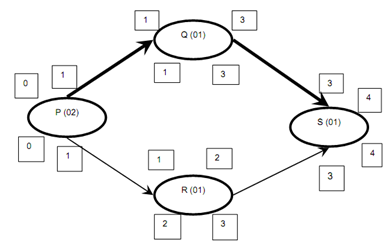Determination of Early Start/Finish and Late Start/Finish Schedule:
To schedule an activity, the next step is to discover when each activity is started and finished. For some activity there is certain time gap that means time when the activity starts and while it finishes, usually referred as slack time. In the CPM procedure we calculate the early start time, early finish time, late start time and late finish time. The short descriptions of these activities are specified in following definition:
Definition 4.2
The Earliest Start (ES) Time for a task is the time at which the work begins, having an assumption that the overall tasks take their estimated time.
Definition 4.3
The Earliest Finishing (EF) Time is time, at which the work might be completed, supposing all task their estimated time.
Definition 4.4
The Latest Start (LS) Time is defined as the time at which work can start on a task without postponing completion of the project.
Definition 4.5
The Latest Finishing (LF) Time is defined as the time at which work may begin on a task without postponing completion of the project.
From above definition, it may be said that the slack time is the difference between the late start and early start time. For the ease of the potential users these time units are placed in a precise position around an activity.

Figure: The Final Network of the Activities
These time units are calculated in two phases as. Forward pass and backward pass as shown in Figure. In forward phase early start and early finish time unit is calculated beginning from the beginning of the network till its end. In this instance, activity P has an early start 0 and early finishing time is 1. Likewise, the ES and EF of Q, R and S are (1, 3), (1, 2) and (3, 4) respectively. While in backward pass, late start and late finishing time is calculated starting from end of the network up to its start point. As per our case, consider activity S having LF and LS 4 and 3. Likewise, the LF and LS of R, Q and P are (3, 2), (3, 1) and (1, 0). Once these data is determined, the slack time is calculated for estimating the critical activities and critical path. Here on evaluating, activities P, Q and S are pointed with 0 slack time that are referred as critical activities and P-Q-S is the critical path.